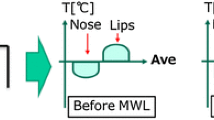Abstract
There is an increasing need for methods to estimate autonomic nerve activity, such as using autonomic nerve activity as an indicator of stress and to improve the activity environment, such that people can live more comfortably. In a previous study, a method for estimating autonomic nervous activity using facial thermal images was established. Such activity was evaluated by obtaining the differential temperature of the nasal region, which is a sympathetic index of autonomic nervous activity, and the less-affected forehead region. However, this method requires the use of an expensive far-infrared camera, which is difficult to obtain and is cited as a problem. Another study suggested acquiring pulse waves and heartbeats by obtaining changes in blood flow from the heart using real facial images. This was obtained using independent component analysis for each Red–Green–Blue (RGB [color model]) component value of the real image. However, the problem with this method is that it cannot evaluate autonomic nerve activity, such as thermal images, because it cannot examine changes in the blood flow in peripheral blood vessels. Therefore, in this study, a method for estimating autonomic nerve activity is proposed, with the same accuracy as thermal images, by obtaining changes in peripheral blood flow from real images taken with an easily usable web camera. To obtain the changes in peripheral blood flow from real images, we used the property that the incident depth of light entering the skin differs depending on the color component. By considering the difference between the R component (which enters the skin at the deepest depth) and the B component (which is almost reflected by the epidermis), we assumed that we could capture the blood flow in the widest range and measure the change in blood flow in the peripheral vasculature. To cause unpleasant irritation, an experiment was conducted in which participants performed a randomly assigned memorization task for 10 min. A rest period of 1 min was provided before and after the mental calculation task, and a subjective evaluation questionnaire was administered during the rest period and before the mental calculation task. The results showed that some subjects exhibited a significant decrease in the R-B component values when they noticed calculation errors, whereas others exhibited an increase in the R-B component values after completing the memorization task. Also, some subjects showed a correspondence between the variation of R-B component values and the results of the questionnaire. Additionally, compared to the conventional method, it was clear that we could obtain real-time and even fine variations in response to event switching. These results suggest that it is possible to evaluate autonomic nervous system activity from real image data to the same extent as from thermal images.











Similar content being viewed by others
Explore related subjects
Discover the latest articles, news and stories from top researchers in related subjects.Data availability
Videos and analysis results used in this study are available upon request.
References
Murata A (1992) Measurement of Mental Workload by Heart Rate Variability Indexes. Jpn J Ergon 28(2):91–98
Hirayanagi K, Iwasaki K, Kanda S, Yajima K (1996) An experimental study on the measurement and assessment of mental workload (MWL). Jpn J Ergon 32(5):251–259
Matsunaga H, Nakazawa H (2000) Relation between mental workload and satisfaction measures evaluated from EEG. Trans Jpn Soc Mech Eng Ser C 66(648):2884–2890
Zenju H, Nozawa A, Tanaka H, Ide H (2004) Estimation of unpleasant and pleasant states by nasal thermogram. IEEJ Trans Electron Inf Syst 124(1):213–214
Mizuno T, Nomura S, Nozawa A, Asano H, Ide H (2010) Evaluation of the effect of intermittent mental workload by nasal skin temperature. IEICE Trans Inf Syst (Japanese Edition) J93-d(4):535–543
Matsuno S, Mizuno T, Asano H, Mito K, Itakura N (2018) Estimating autonomic nerve activity using variance of thermal face images. Artif Life Robot 23(3):367–372
Genno H, Ishikawa K, Kanbara O, Kikumoto M, Fujiwara Y, Suzuki R, Osumi M (1997) Using facial skin temperature to objectively evaluate sensations. Int J Ind Ergon 19(2):161–171
Poh MZ, McDuff DJ, Picard RW (2011) Advancements in noncontact, multiparameter physiological measurements using a webcam. IEEE Trans Biomed Eng 58(1):7–11
CQ Publishing Co. Ltd. (2018) Computer science & technology magazine interface 44(5):19
Dlib C++ Library (2022). http://dlib.net/
OpenCV team. Open Computer Vision Library. https://opencv.org/
Author information
Authors and Affiliations
Corresponding author
Additional information
Publisher's Note
Springer Nature remains neutral with regard to jurisdictional claims in published maps and institutional affiliations.
About this article
Cite this article
Shimizu, M., Matsumoto, Y., Itakura, N. et al. Evaluation of methods for estimating autonomic nervous activity using a web camera. Artif Life Robotics 28, 718–725 (2023). https://doi.org/10.1007/s10015-023-00897-5
Received:
Accepted:
Published:
Issue Date:
DOI: https://doi.org/10.1007/s10015-023-00897-5




